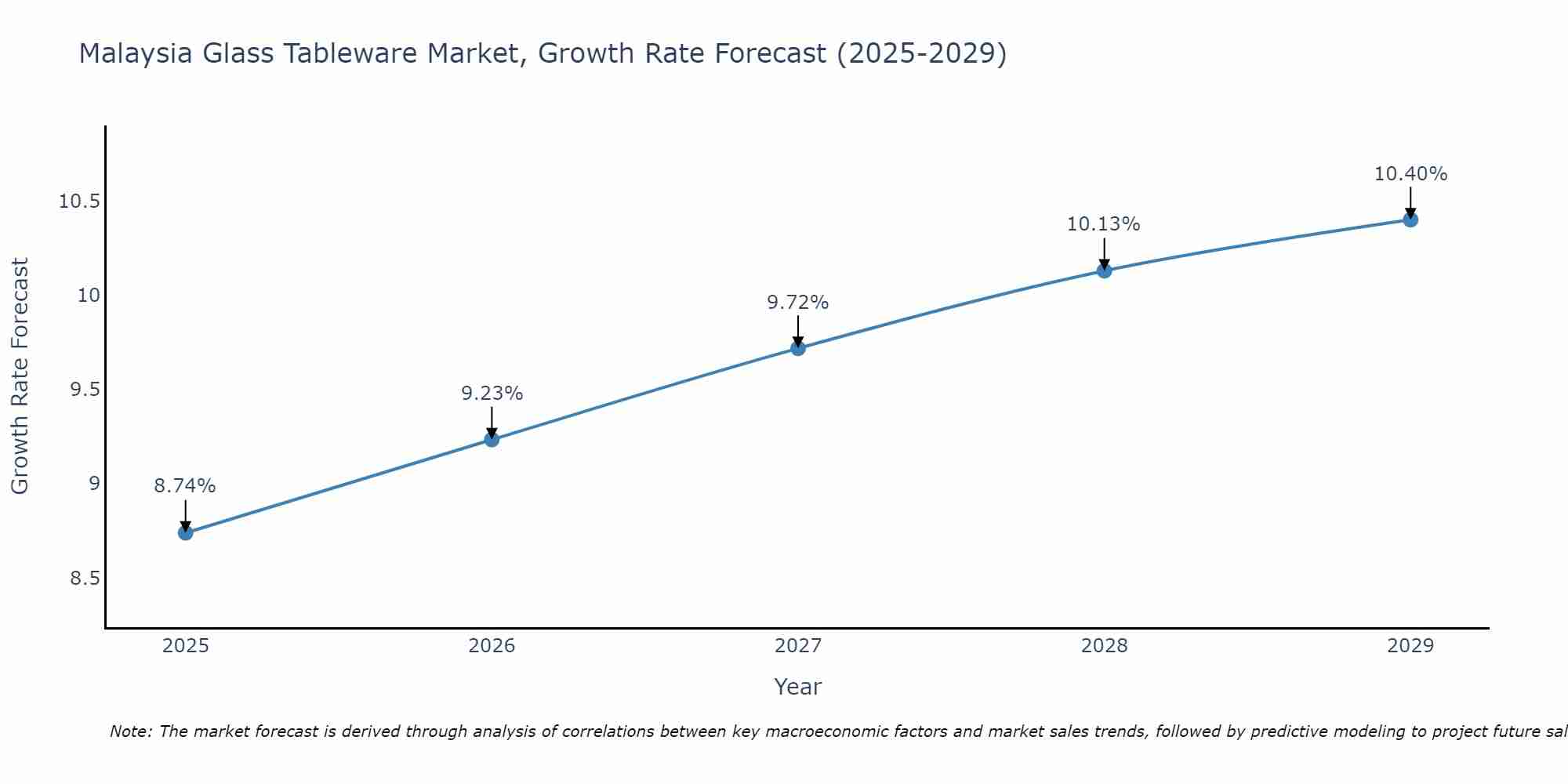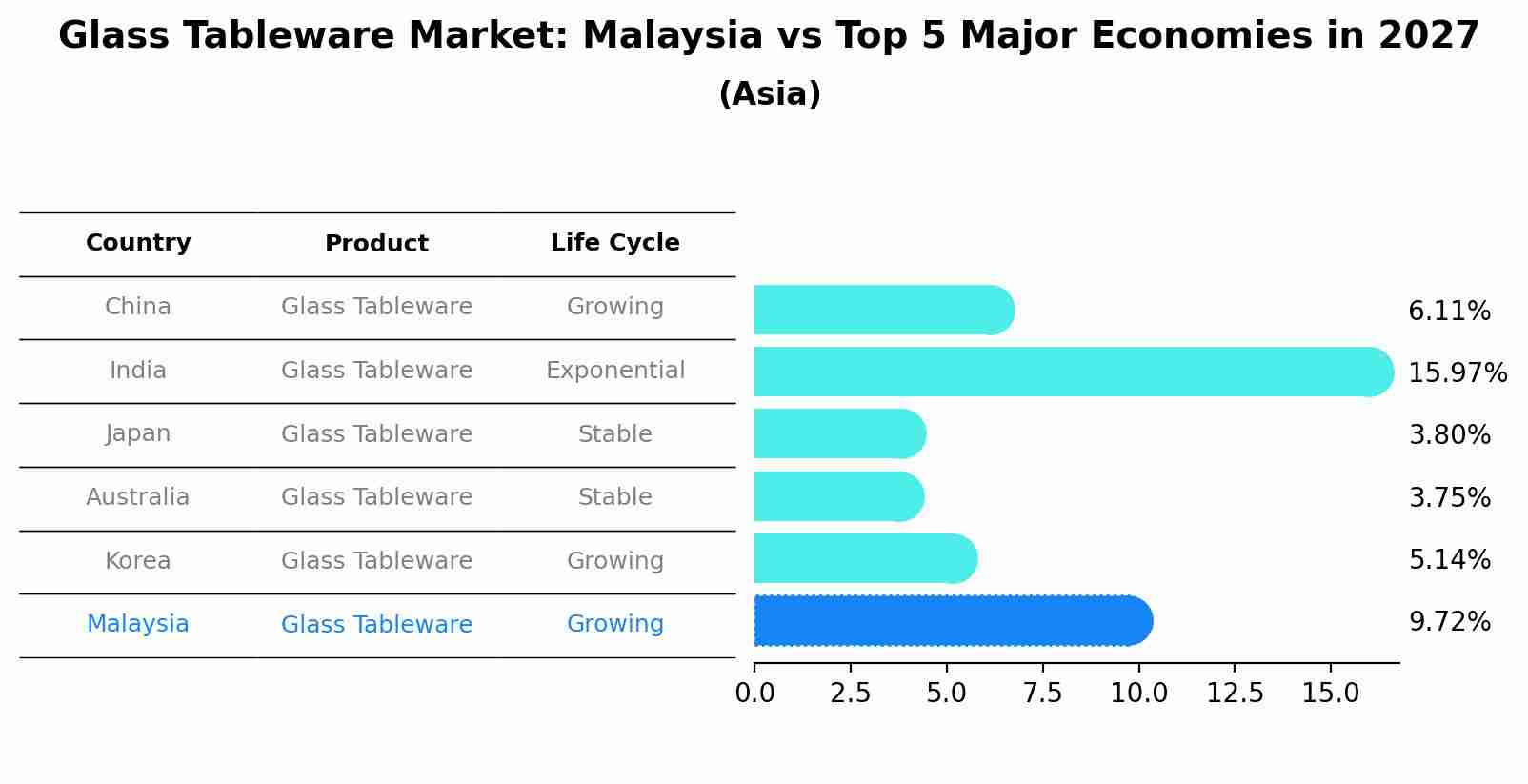Malaysia Glass Tableware Market (2025-2031) Outlook | Companies, Analysis, Forecast, Size, Share, Industry, Revenue, Growth, Trends & Value
| Product Code: ETC214958 | Publication Date: May 2022 | Updated Date: Apr 2025 | Product Type: Market Research Report | |
| Publisher: 6Wresearch | No. of Pages: 60 | No. of Figures: 40 | No. of Tables: 7 | |
Malaysia Glass Tableware Market Size Growth Rate
The Malaysia Glass Tableware Market is likely to experience consistent growth rate gains over the period 2025 to 2029. The growth rate starts at 8.74% in 2025 and reaches 10.40% by 2029.

Glass Tableware Market: Malaysia vs Top 5 Major Economies in 2027 (Asia)
By 2027, the Glass Tableware market in Malaysia is anticipated to reach a growth rate of 9.72%, as part of an increasingly competitive Asia region, where China remains at the forefront, supported by India, Japan, Australia and South Korea, driving innovations and market adoption across sectors.

Malaysia Glass Tableware Market Synopsis
The glass tableware market in Malaysia continues to thrive, primarily driven by the country`s vibrant hospitality industry and a growing preference for elegant and eco-friendly dining options. Glass tableware is known for its aesthetics and suitability for formal and casual dining settings. The market is expected to benefit from the increasing number of restaurants, hotels, and cafes in Malaysia. Moreover, the rising awareness of sustainable and recyclable materials among consumers is likely to boost the demand for glass tableware. Manufacturers may also focus on product innovation, such as tempered glass options and unique designs, to cater to evolving consumer preferences.
Drivers of the Market
The Malaysia glass tableware market is experiencing growth driven by changing consumer preferences and the desire for aesthetically pleasing dining experiences. Glass tableware is favored for its elegant appearance, and the growing culture of dining out and hosting social events is boosting demand. Moreover, the increased awareness of health and hygiene is leading consumers to prefer glass tableware over other materials. Manufacturers are also focusing on innovative designs and durable glassware to cater to consumer demands. The market is expected to continue its positive growth trajectory as consumers invest in quality dining experiences.
Challenges of the Market
The Malaysia glass tableware market faces challenges that influence its outlook. The market`s sensitivity to economic conditions can lead to reduced consumer spending on non-essential items like glass tableware during economic downturns. Changing consumer preferences for alternative materials like ceramics and plastics can also impact demand. Additionally, competition from imported glassware products, which may be cheaper due to lower production costs in other countries, can pose challenges for domestic manufacturers. Environmental concerns and regulations related to glass production and recycling may require investments in sustainable practices.
COVID 19 Impact on the Market
In the glass tableware market, the pandemic initially led to a decline in demand as people shifted to disposable options due to hygiene concerns. However, as the situation improved and consumers became more conscious of sustainability, there was a resurgence in demand for high-quality glass tableware. Manufacturers are now focusing on creating eco-friendly and aesthetically pleasing products to cater to this growing trend.
Key Players in the Market
The glass tableware market in Malaysia features key players like Libbey Glass Malaysia, Arc International Malaysia, and Pasabahce Malaysia. These companies manufacture and distribute a wide range of glass tableware products, including glassware, dinnerware, and serveware, catering to both residential and commercial customers.
Key Highlights of the Report:
- Malaysia Glass Tableware Market Outlook
- Market Size of Malaysia Glass Tableware Market, 2024
- Forecast of Malaysia Glass Tableware Market, 2031
- Historical Data and Forecast of Malaysia Glass Tableware Revenues & Volume for the Period 2021-2031
- Malaysia Glass Tableware Market Trend Evolution
- Malaysia Glass Tableware Market Drivers and Challenges
- Malaysia Glass Tableware Price Trends
- Malaysia Glass Tableware Porter's Five Forces
- Malaysia Glass Tableware Industry Life Cycle
- Historical Data and Forecast of Malaysia Glass Tableware Market Revenues & Volume By Product for the Period 2021-2031
- Historical Data and Forecast of Malaysia Glass Tableware Market Revenues & Volume By Dinner Glass Tableware for the Period 2021-2031
- Historical Data and Forecast of Malaysia Glass Tableware Market Revenues & Volume By Beverage Glass Tableware for the Period 2021-2031
- Historical Data and Forecast of Malaysia Glass Tableware Market Revenues & Volume By Application for the Period 2021-2031
- Historical Data and Forecast of Malaysia Glass Tableware Market Revenues & Volume By Household Glass Tableware for the Period 2021-2031
- Historical Data and Forecast of Malaysia Glass Tableware Market Revenues & Volume By Commercial Glass Tableware for the Period 2021-2031
- Historical Data and Forecast of Malaysia Glass Tableware Market Revenues & Volume By Distribution Channel for the Period 2021-2031
- Historical Data and Forecast of Malaysia Glass Tableware Market Revenues & Volume By Offline Glass Tableware Sales for the Period 2021-2031
- Historical Data and Forecast of Malaysia Glass Tableware Market Revenues & Volume By Online Glass Tableware Sales for the Period 2021-2031
- Malaysia Glass Tableware Import Export Trade Statistics
- Market Opportunity Assessment By Product
- Market Opportunity Assessment By Application
- Market Opportunity Assessment By Distribution Channel
- Malaysia Glass Tableware Top Companies Market Share
- Malaysia Glass Tableware Competitive Benchmarking By Technical and Operational Parameters
- Malaysia Glass Tableware Company Profiles
- Malaysia Glass Tableware Key Strategic Recommendations
Frequently Asked Questions About the Market Study (FAQs):
1 Executive Summary |
2 Introduction |
2.1 Key Highlights of the Report |
2.2 Report Description |
2.3 Market Scope & Segmentation |
2.4 Research Methodology |
2.5 Assumptions |
3 Malaysia Glass Tableware Market Overview |
3.1 Malaysia Country Macro Economic Indicators |
3.2 Malaysia Glass Tableware Market Revenues & Volume, 2021 & 2031F |
3.3 Malaysia Glass Tableware Market - Industry Life Cycle |
3.4 Malaysia Glass Tableware Market - Porter's Five Forces |
3.5 Malaysia Glass Tableware Market Revenues & Volume Share, By Product, 2021 & 2031F |
3.6 Malaysia Glass Tableware Market Revenues & Volume Share, By Application, 2021 & 2031F |
3.7 Malaysia Glass Tableware Market Revenues & Volume Share, By Distribution Channel, 2021 & 2031F |
4 Malaysia Glass Tableware Market Dynamics |
4.1 Impact Analysis |
4.2 Market Drivers |
4.3 Market Restraints |
5 Malaysia Glass Tableware Market Trends |
6 Malaysia Glass Tableware Market, By Types |
6.1 Malaysia Glass Tableware Market, By Product |
6.1.1 Overview and Analysis |
6.1.2 Malaysia Glass Tableware Market Revenues & Volume, By Product, 2021-2031F |
6.1.3 Malaysia Glass Tableware Market Revenues & Volume, By Dinner Glass Tableware, 2021-2031F |
6.1.4 Malaysia Glass Tableware Market Revenues & Volume, By Beverage Glass Tableware, 2021-2031F |
6.2 Malaysia Glass Tableware Market, By Application |
6.2.1 Overview and Analysis |
6.2.2 Malaysia Glass Tableware Market Revenues & Volume, By Household Glass Tableware, 2021-2031F |
6.2.3 Malaysia Glass Tableware Market Revenues & Volume, By Commercial Glass Tableware, 2021-2031F |
6.3 Malaysia Glass Tableware Market, By Distribution Channel |
6.3.1 Overview and Analysis |
6.3.2 Malaysia Glass Tableware Market Revenues & Volume, By Offline Glass Tableware Sales, 2021-2031F |
6.3.3 Malaysia Glass Tableware Market Revenues & Volume, By Online Glass Tableware Sales, 2021-2031F |
7 Malaysia Glass Tableware Market Import-Export Trade Statistics |
7.1 Malaysia Glass Tableware Market Export to Major Countries |
7.2 Malaysia Glass Tableware Market Imports from Major Countries |
8 Malaysia Glass Tableware Market Key Performance Indicators |
9 Malaysia Glass Tableware Market - Opportunity Assessment |
9.1 Malaysia Glass Tableware Market Opportunity Assessment, By Product, 2021 & 2031F |
9.2 Malaysia Glass Tableware Market Opportunity Assessment, By Application, 2021 & 2031F |
9.3 Malaysia Glass Tableware Market Opportunity Assessment, By Distribution Channel, 2021 & 2031F |
10 Malaysia Glass Tableware Market - Competitive Landscape |
10.1 Malaysia Glass Tableware Market Revenue Share, By Companies, 2024 |
10.2 Malaysia Glass Tableware Market Competitive Benchmarking, By Operating and Technical Parameters |
11 Company Profiles |
12 Recommendations |
13 Disclaimer |
- Single User License$ 1,995
- Department License$ 2,400
- Site License$ 3,120
- Global License$ 3,795
Search
Related Reports
- Portugal Electronic Document Management Market (2025-2031) | Strategy, Consumer Insights, Analysis, Investment Trends, Opportunities, Growth, Size, Share, Industry, Revenue, Segments, Value, Segmentation, Supply, Forecast, Restraints, Outlook, Competition, Drivers, Trends, Demand, Pricing Analysis, Competitive, Strategic Insights, Companies, Challenges
- France Electronic Document Management Market (2025-2031) | Strategy, Consumer Insights, Analysis, Investment Trends, Opportunities, Growth, Size, Share, Industry, Revenue, Segments, Value, Segmentation, Supply, Forecast, Restraints, Outlook, Competition, Drivers, Trends, Demand, Pricing Analysis, Competitive, Strategic Insights, Companies, Challenges
- Portugal Occupational Health & Safety Services Market (2025-2031) | Strategy, Consumer Insights, Analysis, Investment Trends, Opportunities, Growth, Size, Share, Industry, Revenue, Segments, Value, Segmentation, Supply, Forecast, Restraints, Outlook, Competition, Drivers, Trends, Demand, Pricing Analysis, Competitive, Strategic Insights, Companies, Challenges
- Netherlands Occupational Health and Safety Services Market (2025-2031) | Strategy, Consumer Insights, Analysis, Investment Trends, Opportunities, Growth, Size, Share, Industry, Revenue, Segments, Value, Segmentation, Supply, Forecast, Restraints, Outlook, Competition, Drivers, Trends, Demand, Pricing Analysis, Competitive, Strategic Insights, Companies, Challenges
- Belgium and Luxembourg Facility Management Market (2025-2031) | Strategy, Consumer Insights, Analysis, Investment Trends, Opportunities, Growth, Size, Share, Industry, Revenue, Segments, Value, Segmentation, Supply, Forecast, Restraints, Outlook, Competition, Drivers, Trends, Demand, Pricing Analysis, Competitive, Strategic Insights, Companies, Challenges
- Russia Women Intimate Apparel Market (2025-2031) | Strategy, Consumer Insights, Analysis, Investment Trends, Opportunities, Growth, Size, Share, Industry, Revenue, Segments, Value, Segmentation, Supply, Forecast, Restraints, Outlook, Competition, Drivers, Trends, Demand, Pricing Analysis, Competitive, Strategic Insights, Companies, Challenges
- Africa Chocolate Market (2025-2031) | Size, Share, Trends, Growth, Revenue, Analysis, Forecast, industry & Outlook
- Global Hydroxychloroquine And Chloroquine Market (2025-2031) | Industry, Trends, Size, Outlook, Growth, Value, Companies, Revenue, Analysis, Share, Forecast
- Saudi Arabia Plant Maintenance Market (2025-2031) | Industry, Size, Growth, Revenue, Value, Companies, Forecast, Analysis, Share & Trends
- Taiwan Electric Truck Market (2025-2031) | Outlook, Industry, Revenue, Size, Forecast, Growth, Analysis, Share, Companies, Value & Trends
Industry Events and Analyst Meet
Our Clients
Whitepaper
- Middle East & Africa Commercial Security Market Click here to view more.
- Middle East & Africa Fire Safety Systems & Equipment Market Click here to view more.
- GCC Drone Market Click here to view more.
- Middle East Lighting Fixture Market Click here to view more.
- GCC Physical & Perimeter Security Market Click here to view more.
6WResearch In News
- Doha a strategic location for EV manufacturing hub: IPA Qatar
- Demand for luxury TVs surging in the GCC, says Samsung
- Empowering Growth: The Thriving Journey of Bangladesh’s Cable Industry
- Demand for luxury TVs surging in the GCC, says Samsung
- Video call with a traditional healer? Once unthinkable, it’s now common in South Africa
- Intelligent Buildings To Smooth GCC’s Path To Net Zero













